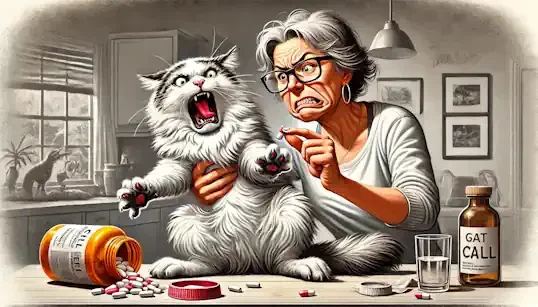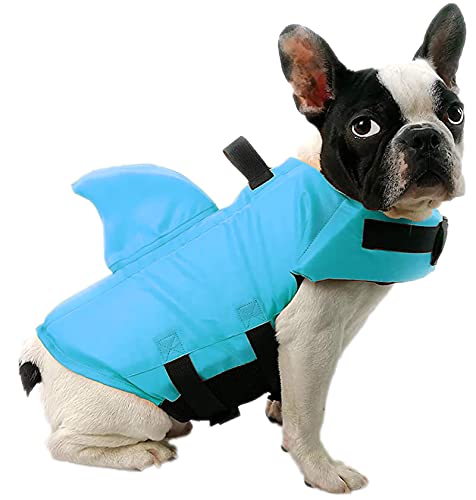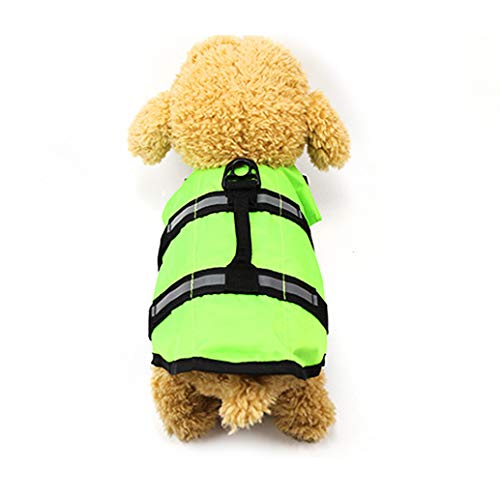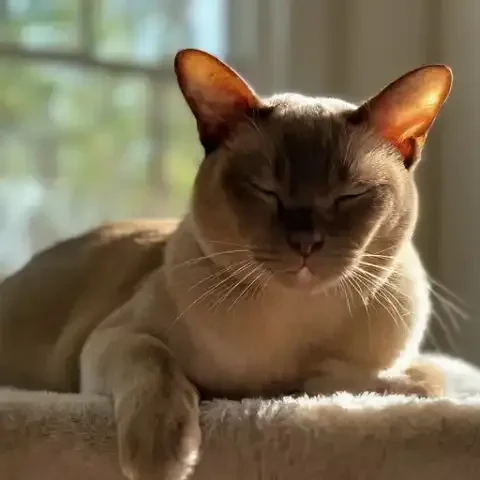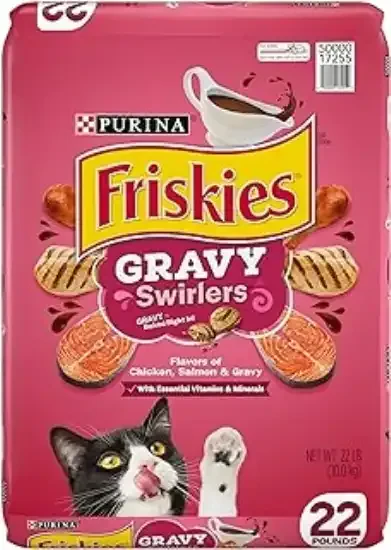The wrestling match. The strategic spitting. The frantic search under the sofa for that rogue, half-dissolved pill. If you've ever had to give a cat a pill, you know it can feel less like a loving act of care and more like a clandestine operation fraught with peril and the distinct possibility of losing a finger or two. It's a universal struggle for cat owners, a challenge that unites us in a shared experience of feline resistance and impressive pill-avoidance techniques. You’re not alone in this! It's not just your cat being particularly stubborn or you lacking some secret pilling prowess. Cats are inherently clever, acutely sensitive to anything "foreign" entering their mouths, and masters of the art of escape. Their resistance isn't personal; it's feline nature in its purest, most pill-rejecting form.
But despite the often comical, often frustrating, and sometimes slightly terrifying nature of pilling a cat, it's undeniably important. Medication compliance, as unglamorous as the phrase sounds, is absolutely vital to your cat's health and well-being. Whether it’s antibiotics to fight an infection, pain medication to ease discomfort, or long-term medication to manage a chronic condition, getting that pill into your cat can be the critical difference between recovery and continued illness, between preventative care and escalating health issues. Skipping doses or failing to administer medication properly can compromise treatment effectiveness, prolong suffering, and even have serious consequences for your cat’s health. So, how do we bridge this gap? How do we move from the chaotic, stressful pilling predicament to a more successful, and dare we say, less traumatic experience for both cat and owner? The good news is, it is absolutely possible to become a more confident and effective pill-giver. This isn't about brute force or stressful showdowns. It's about understanding feline behavior, mastering gentle techniques, and employing clever strategies that work with your cat's nature, not against it. This article is your comprehensive guide, your arsenal of tips and tricks, to navigate the pilling process with greater ease and success. We'll explore everything from preparation and mindset to direct pilling techniques and sneaky disguise methods, empowering you to become a pilling pro and ensuring your cat receives the medication they need, with as little stress as possible for everyone involved.
Before you even reach for the pill bottle, remember that preparation is absolutely key to a smoother, more successful pilling experience. Think of it as setting the stage – the right environment, mindset, and supplies can significantly increase your chances of success and minimize stress for both you and your feline companion. First and foremost, understand your cat's unique personality. Just like people, cats have individual temperaments and react differently to handling and new experiences. Is your cat generally cooperative and tolerant of handling, or are they more prone to resistance and anxiety? Acknowledge your cat’s baseline temperament. A naturally laid-back and trusting cat might be more receptive to direct pilling, while a more nervous or reactive cat might require a stealthier approach. Think about what specifically stresses your cat. Are they sensitive to loud noises? Do sudden movements startle them? Do they dislike being held tightly or feeling confined? Identifying these stress triggers allows you to proactively minimize them during the pilling process. Create a calm and predictable environment to reduce their anxiety from the outset.
Gather all your supplies before you even approach your cat. Fumbling around for water or treats while your cat is already in pilling mode is a recipe for escalating stress. Naturally, you'll need the pill itself. Double-check the medication name and, crucially, the dosage. Mistakes happen, and verifying you have the correct medication and dose before you start is a simple but vital safety step. Have water readily available, either in a small dish or a syringe (without the needle, of course!). Water can help the pill go down smoothly and can also be used to rinse your cat’s mouth afterward if needed, especially if the pill has a lingering unpleasant taste. Consider pill pockets or enticing treats. These are your allies in the disguise department, and we’ll delve deeper into stealth pilling techniques later. Having a few options on hand allows you to be adaptable. A towel can be an invaluable, though sometimes controversial, tool. Used correctly, a towel can provide gentle restraint, keeping paws contained and preventing scratches without feeling overly restrictive. We’ll discuss towel wrapping techniques in more detail, but have one nearby as an option, even if you hope not to need it. And perhaps the most crucial supply? Yourself. Your calm and patient demeanor is paramount. Cats are incredibly sensitive to our energy and emotions. If you’re tense, anxious, or rushed, your cat will likely mirror that stress, making the pilling process even more difficult. Take a few deep breaths, approach the situation with a calm and confident mindset, and remember that your patience is your greatest asset.
Choose the right environment for your pilling attempt. A quiet and calm space, free from distractions, is essential. Loud noises, sudden movements, or the presence of other pets can all heighten your cat’s anxiety and make them less cooperative. Opt for a comfortable and familiar space for your cat – their favorite room, a quiet corner, or even their carrier if they view it as a safe space (though usually not recommended for pilling unless they are already very comfortable inside). Good lighting is practical but often overlooked. You need to be able to clearly see what you’re doing – opening their mouth, placing the pill, ensuring they swallow. Adequate lighting makes the process smoother and more efficient.
Timing your pilling attempt strategically can also significantly impact your success rate. Consider meal times. For some cats, pilling right before they eat can be effective. They may be more distracted by the anticipation of food and less focused on resisting the pill. For other cats, pilling during a meal, hidden in a small, irresistible morsel of wet food, can be the sneakiest approach. And for some, pilling after a meal, when they are more relaxed and perhaps a bit drowsy, works best. Experiment to see what timing seems to work best with your individual cat. Avoid attempting to pill your cat when they are already anxious or agitated. If they are displaying signs of stress – flattened ears, dilated pupils, hissing, or growling – forcing a pill at that moment is likely to escalate the situation and create negative associations with pilling in the future. If your cat requires long-term medication, establishing a routine, if possible, can be helpful. Administering the pill at the same time each day, perhaps associated with a specific activity like playtime or a treat, can help some cats become more accustomed to the routine, though full acceptance is rarely achieved!
For those cats who are relatively cooperative, or when disguise methods simply aren't working, mastering the direct pilling technique can be the most efficient approach. Gentle restraint, when necessary, is about providing secure control without causing fear or pain. The towel wrap, often referred to as the “burrito method,” can be incredibly helpful for containing paws and preventing scratches, especially with more wriggly or scratch-prone cats. Lay a towel flat, place your cat in the center, and gently wrap the towel around their body, leaving only their head exposed. The wrap should be snug enough to prevent pawing but loose enough to allow comfortable breathing. If you have a willing partner, having someone assist can be immensely beneficial. One person can gently and securely hold the cat, providing reassurance and preventing escape, while the other person focuses on administering the pill. If you are pilling solo, the kneeling position can offer a secure yet comfortable way to restrain your cat. Position your cat between your knees, facing away from you. This provides gentle body contact and helps prevent them from backing away or twisting around during the pilling process.
Opening your cat's mouth gently and effectively is crucial for safe and successful pilling. There are both one-handed and two-handed techniques, and the best approach often depends on your cat’s size and cooperation level, as well as your own dexterity. The one-handed technique involves using your non-dominant hand to gently tilt your cat’s head back slightly, naturally causing their lower jaw to drop open slightly. Then, using your index finger and thumb of your dominant hand, you can gently apply pressure to the jaw joints, located just behind the canine teeth, to further open their mouth. The two-handed technique provides more control but requires a bit more coordination. Use the thumb and index finger of one hand to gently hold the upper jaw, just behind the canine teeth. Use the index finger of your other hand to gently press down on the lower jaw, just behind the canine teeth, to open the mouth. Regardless of the technique, remember to always tilt your cat’s chin slightly upwards. This naturally encourages the lower jaw to open and aligns the throat for easier swallowing. Avoid forcing the mouth open wide or applying excessive pressure, which can be uncomfortable and stressful for your cat.
Pill placement is all about speed and accuracy. The goal is to place the pill as far back on the tongue as possible, triggering their natural swallowing reflex. Using your index finger of your dominant hand, gently push the pill over the base of the tongue, towards the back of the mouth. Aim for the area just behind the raised part of the tongue. Speed is key here – a quick, decisive motion is often less stressful than a slow, hesitant one. For some owners, a pill popper can be a helpful tool, particularly for cats who are quick to clamp their mouths shut or for those who prefer not to put their fingers too far into their cat’s mouth. Pill poppers are essentially plastic plungers that hold the pill and allow you to propel it to the back of the throat with a quick push. Practice using a pill popper beforehand to get comfortable with its mechanics and ensure smooth pill delivery.
Ensuring your cat actually swallows the pill is the final critical step. After placing the pill, gently close your cat's mouth and hold it closed, but don’t clamp down tightly. A gentle, reassuring hold is sufficient. Encourage swallowing by gently stroking your cat’s throat downwards, from chin to chest. This tactile cue often triggers the swallowing reflex. Some owners find that gently blowing lightly on their cat’s nose can also stimulate a swallow reflex. Immediately following pill administration, use a syringe (without the needle!) to give a small amount of water into the side of their mouth. This helps to wash the pill down, ensure it doesn't get stuck in the esophagus, and can also help rinse away any lingering taste, reducing the likelihood of them spitting it out later.
Remember, mastering the direct pilling technique takes practice and patience. Don't get discouraged if your first few attempts are less than perfect. Practice the mouth-opening and pill-placement motions with something harmless first, like a small, soft treat or even just your finger. This will help you become more comfortable and confident with the technique before you introduce the actual pill. Keep pilling sessions short and positive, or at least neutral. If it becomes too stressful for either of you, stop, take a break, and try again later. Dragging out a stressful pilling session is counterproductive and will only make future attempts more challenging.
For cats who are masters of pill detection, or who become highly resistant to direct pilling, stealth is your greatest weapon. Disguising the pill in something irresistible can often be the key to sneaky success. Pill pockets and commercially available pill treats are specifically designed to mask medication. These palatable treats have a built-in pocket or soft center where you can easily conceal a pill. The key is to ensure the pill is fully enclosed within the pocket and that your cat eats the entire treat, pill and all, not just nibbling around it and leaving the medication behind. If commercial pill pockets aren't appealing to your cat, or you prefer more budget-friendly options, soft treats and cheeses can work wonderfully. Small pieces of cheese (check for cat-safe varieties, avoiding overly salty or strong cheeses), cream cheese, or soft, pate-style cat treats can be molded around a pill to create a palatable disguise. When hiding a pill in food or treats, strategic preparation is essential. Mold the treat firmly around the pill, ensuring it's completely concealed and there are no telltale edges or scents of medication escaping. Offer the disguised treat enticingly, as you would any other treat. Observe your cat carefully as they eat. Make sure they consume the entire portion containing the pill and haven't cleverly eaten around it, leaving the medication behind in your hand or on the floor.
Hiding pills in food, particularly wet food, is a classic and often effective stealth method. Mix the pill with a small amount of your cat’s favorite wet food – tuna, salmon, pate-style food, or even a tempting broth can work wonders to mask both the taste and texture of the pill. Create “pill balls” of food by mixing a small amount of wet food into a ball shape, with the pill carefully hidden in the center. These bite-sized balls can be offered as tempting treats. Regardless of how you mix the pill with food, careful observation is crucial. Ensure your cat eats the entire portion of food containing the pill, not just licking around it or consuming part of the meal and leaving the medicated portion behind.
In some cases, crushing or powdering pills can be a viable option to mix with food, but veterinarian approval is absolutely essential before crushing any medication. Not all pills can be safely crushed; some medications are time-released or coated to protect the stomach lining, and crushing them can alter their effectiveness or even be harmful. Always, always confirm with your veterinarian that crushing your cat’s specific medication is safe and will not compromise its efficacy. If crushing is approved, use a dedicated pill crusher or a mortar and pestle to create a fine powder. Mix the powdered medication with a small amount of highly palatable wet food, plain yogurt (check for xylitol-free varieties!), or unsweetened baby food (again, check ingredients for cat-safe options). Be aware that even when powdered and mixed, some medications have a naturally bitter or unpleasant taste that even strong flavors may not fully mask, so palatability can still be an issue.
Finally, for long-term medications or for cats who are consistently difficult to pill, discuss flavored medications with your veterinarian. Compounding pharmacies can often create customized formulations of medications in palatable liquid or chewable forms, often flavored with cat-friendly flavors like chicken, fish, or tuna. These flavored medications can significantly improve medication compliance, especially for chronic conditions requiring daily administration. While compounded medications may sometimes be slightly more expensive than standard pills, the improved ease of administration and reduced stress for both you and your cat can make them a worthwhile investment, particularly for long-term treatment.
Even with the best preparation and techniques, pilling cats can still present challenges. Let's troubleshoot some common problems and arm you with expert tips to overcome them. If your cat consistently spits out the pill immediately, consider a few common culprits. The pill might be placed too far forward in the mouth, not far enough back to trigger the swallowing reflex. Re-emphasize aiming for the back of the tongue. You might be hesitating or moving too slowly, allowing your cat to anticipate the pill and reject it. Practice speed and confidence in your movements. Or, the bitter taste of the medication might be immediately offensive to your cat. In this case, rely more heavily on disguise methods – pill pockets, food, or explore flavored medication options.
If your cat outright refuses to open their mouth, remember gentle persistence is key, but so is knowing when to stop. Avoid forcing their mouth open aggressively, which will only escalate resistance and fear. Employ the towel wrap for better control if gentle restraint seems necessary to encourage mouth opening. If the direct method is consistently failing, switch tactics entirely and focus on disguise methods.
If your cat becomes aggressive, scratches, or bites during pilling attempts, prioritize safety – both yours and your cat's. Don't push the situation if it's escalating into true aggression. If safe restraint is possible, the towel wrap can provide some protection. However, if your cat becomes genuinely distressed or aggressive, it's time to consult your veterinarian for alternative medication forms. Liquid medications, injectable medications administered at the vet’s office, or compounded flavored medications might be more suitable options for a highly pill-resistant or aggressive cat.
And now, some general expert tips for ultimate pilling success: Stay calm and confident. Your energy and demeanor directly impact your cat’s anxiety levels. Be quick but gentle. Efficiency minimizes stress, but gentleness builds trust. Positive reinforcement is crucial. Always offer a treat, praise, and affection immediately after pilling, even if the process wasn’t perfect. Consistency, when possible, can help some cats adjust to a routine, though don't expect complete acceptance. And above all, don't give up! Persistence and trying different methods often lead to eventual success. Finally, know when to seek veterinary help for the pilling process itself. If you consistently struggle, if pilling is causing extreme stress for your cat, or if aggression becomes a concern, don't hesitate to talk to your veterinarian or a veterinary technician. They can offer personalized advice, demonstrate alternative techniques, and explore different medication formulations to make medication time less of a battle and more of a manageable moment of care for both you and your beloved feline friend. You can do this!
